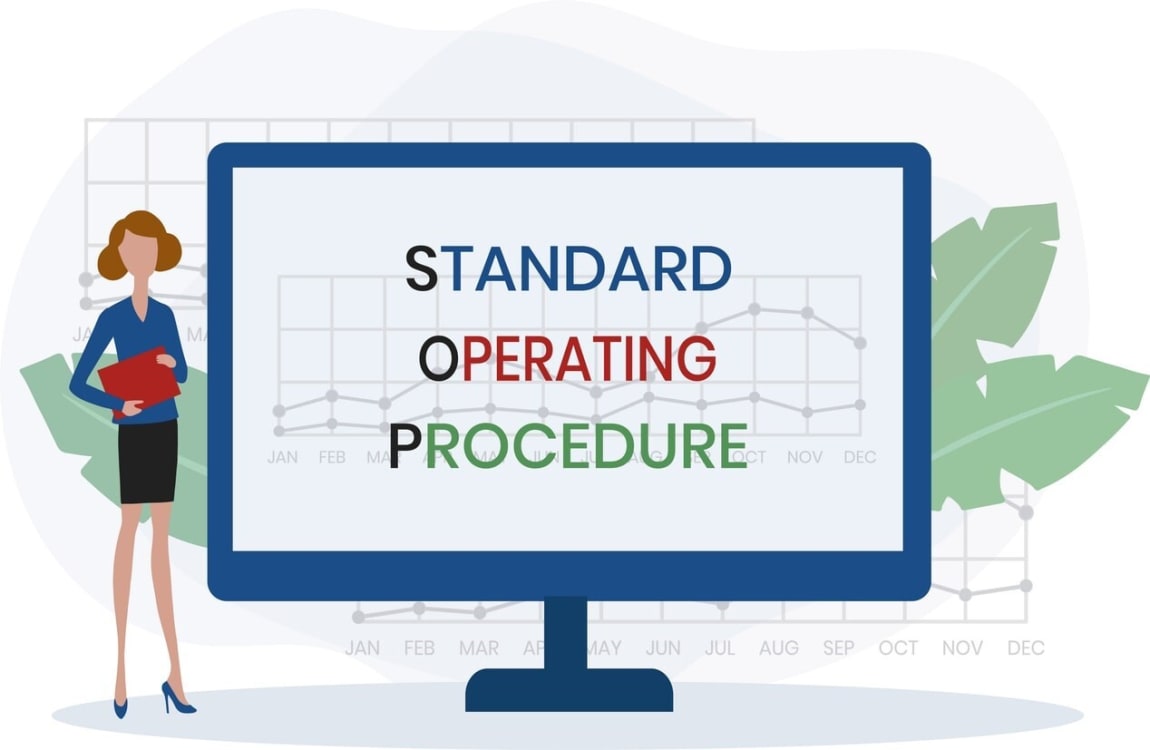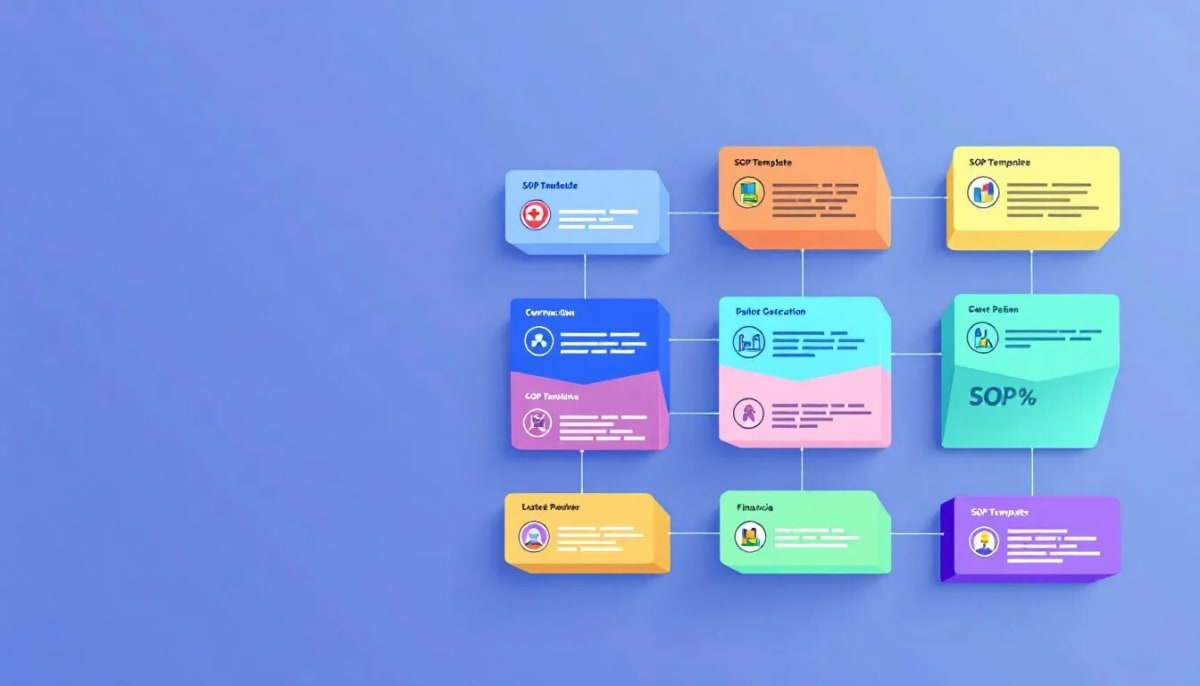Creating consistent processes is critical for running an efficient business, but documenting them can feel overwhelming. That’s where an SOP template comes in. Whether you’re looking for an SOP template in Word, a free SOP template you can customize, or a complete SOP document template to share with your team, these tools make it easy to standardize how tasks get done. In this article, we’ll break down what SOP templates are, the benefits of using them, and how to choose the right format for your needs.
Key Takeaways
- SOP templates provide a consistent framework for documenting business processes, enhancing communication and efficiency across teams.
- Different types of SOP templates, like step-by-step guides, hierarchical structures, and flowcharts, cater to varying complexities of tasks and improve clarity.
- Collaboration tools like Google Docs and Asana streamline the creation, sharing, and updating of SOPs, promoting better adherence and compliance within organizations.
What is an SOP Template?

An SOP (Standard Operating Procedure) template is a structured guide used to document business processes, ensuring tasks are carried out consistently across teams. These templates provide clear, step-by-step instructions that help maintain quality, reduce errors, and streamline communication.
More than just paperwork, SOPs are essential tools for improving efficiency and managing teams effectively. By offering standardized guidelines, they help employees stay aligned, save time, and minimize miscommunication.
Whether formatted as simple checklists or detailed flowcharts, SOP templates play a key role in creating reliable, repeatable processes that keep operations running smoothly.
Benefits of Using SOP Templates

Using an SOP template offers numerous benefits that go beyond simple documentation.
They streamline the process of creating standard operating procedures by providing a predefined structure, which saves time and reduces the effort required to develop comprehensive SOPs. Whether you’re working from an SOP template Word file, downloading an SOP template free, or customizing a detailed SOP document template, having that structure in place helps employees focus on task execution rather than constantly seeking clarification.
As a result, overall business efficiency and productivity are enhanced. Moreover, SOP templates play a critical role in maintaining consistent quality and quality control. By standardizing the outcomes of tasks performed by different employees, an SOP template ensures that every team member adheres to the same high standards. This consistency is particularly important in customer service, where delivering a uniform experience can significantly contribute to brand trust and loyalty.
Additionally, well-defined SOPs supported by a clear template help organizations pass regulatory audits by demonstrating adherence to established guidelines, thus ensuring compliance with industry regulations.
Types of SOP Templates

SOP templates come in various formats, each designed to enhance clarity and efficiency in different processes. The choice of format depends on the complexity of the task and the specific needs of the business. Common SOP formats include step-by-step guides, hierarchical structures, and flowcharts, each serving a unique purpose.
Understanding these different types can help you select the most appropriate template for your organization’s needs.
Step-by-Step SOP Templates
Step-by-step SOP templates are ideal for straightforward processes requiring clear, sequential work instructions. These templates are particularly useful in the IT industry and other technical fields where precise, detailed instructions are crucial. These templates break down tasks into simple, manageable steps, enabling teams to perform time-sensitive processes efficiently and accurately.
Including visuals such as images and screenshots can further enhance the clarity of step-by-step SOPs, minimizing text and making the procedures easier to understand. This approach not only helps in reducing procedural questions but also ensures that team members can quickly grasp and execute the required tasks, leading to improved performance, reduced errors, and improved efficiency.
Hierarchical SOP Templates
Hierarchical SOP templates are best suited for complex processes involving multiple departments and detailed instructions. These templates:
- Break down procedures into manageable sub-tasks and categories, making it easier to navigate and execute intricate workflows.
- Organize information hierarchically to provide a clear structure.
- Help team members understand their roles and responsibilities within the broader process, following a hierarchical SOP format.
An HR SOP template for the hiring process might include sections such as:
- Job posting
- Candidate screening
- Interview scheduling
- Onboarding
Each section contains specific steps and guidelines. This structured approach ensures that all aspects of the specific work process are covered comprehensively, reducing the likelihood of errors and ensuring a smooth, efficient workflow. This is a step-by-step guide to achieving that goal and tracking progress.
Flowchart SOP Templates
Flowchart SOP templates:
- Use diagrams to outline different scenarios and corresponding action plans, making them ideal for conditional processes or approval workflows.
- Visually represent steps and decisions, offering better insight into overall processes and individual contributions.
- Facilitate dynamic process navigation, helping team members quickly understand and follow the required steps.
Tools like Lucidchart and Whimsical can be used to create these flowcharts, offering a user-friendly interface for designing and managing complex processes. For example, a flowchart SOP for submitting an expense report might include steps for filling out the report, obtaining approvals, and processing reimbursement, all visually mapped out to ensure clarity and efficiency.
How to Choose the Right SOP Template

Selecting the right SOP template requires considering factors such as complex tasks, end-user needs, and organizational goals. A step-by-step format is often more effective for straightforward tasks, offering clear instructions that are easy to follow. Using a simple sop template can further streamline this process, making it a better idea for certain tasks.
On the other hand, complex topics may benefit from a hierarchical format, which includes detailed sections and a table of contents to help navigate the intricacies of the process. A flowchart SOP format can offer flexibility for processes with conditional steps, allowing team members to visually understand different perspectives and required actions in depth.
Identifying the end-user is vital to tailor the SOP to their specific needs and usage. Involving end-users in the feedback process can enhance the clarity and utility of the SOP, ensuring it meets their requirements and is easy to follow.
Considering the procedure’s scope helps determine the necessary details of the SOP. Factors such as audience, objectives, and the level of detail required should be taken into account when choosing an SOP format. Evaluating these factors helps organizations select the most appropriate template, ensuring effective documentation and execution of their processes.
Creating SOPs with Google Docs Templates
Google Docs offers a range of features that make it an excellent tool for creating SOPs, including a Google Docs SOP template:
- Collaboration features allow multiple users to edit SOPs simultaneously, facilitating real-time feedback.
- Ensures that everyone is on the same page.
- Collaboration during the SOP creation process allows team members to contribute their insights.
- Results in more comprehensive and accurate SOPs.
The platform’s sharing options make it easy to distribute SOPs across teams, ensuring that all relevant stakeholders have access to the documents they need. Additionally, Google Docs provides version history, allowing users to track changes made to SOP documents and revert to previous versions if necessary. This combination of collaboration, customization, and version control makes Google Docs a powerful tool for creating effective SOPs.
Customizing SOP Templates in Microsoft Word
Customizing SOP templates in Microsoft Word offers several advantages, including the ability to focus on the content of the document and ensure it meets specific organizational needs. Microsoft Word SOP templates offer a solid foundation for communicating procedures, allowing users to personalize them to fit specific requirements.
Users can edit the example provided in the Microsoft Word template to better fit their needs and accurately fill out the Procedure Name field, ensuring that the SOP is tailored to their organization’s processes. This flexibility and control over the content make Microsoft Word an excellent choice for creating detailed, customized SOPs.
Best Practices for Writing SOPs
Writing effective SOPs requires clarity and structure to minimize misinterpretation and ensure smooth execution. A well-designed SOP template makes this process easier by offering a ready-made framework you can adapt. Key points to keep in mind include:
-
Use an active voice to maintain clarity and directness, making the procedures easier to understand and follow.
-
Leverage a structured SOP template, whether it’s an SOP template Word file, an SOP template free download, or a detailed SOP document template, to ensure you cover essential elements like purpose, scope, and procedure.
-
Provide a clear framework that outlines tasks step by step.
-
Gather stakeholder feedback during the SOP creation process to confirm feasibility and ease of execution. This also ensures you’re using the right language and tone, while aligning the SOP with company values and standards.
Finally, remember that SOPs aren’t one-and-done. Regularly updating them using your chosen SOP template is crucial to keep them relevant and effective as regulations or internal processes evolve.
Real-World Examples of SOP Templates

Real-world examples of SOP templates showcase their practical applications and benefits across various departments. An HR SOP template for screening applicants ensures an impartial review, helping to identify qualified candidates efficiently. Onboarding SOPs for new hires create a welcoming first-day experience, ensuring necessary resources are provided and improving employee retention.
Marketing SOPs, such as those for copy editing or launching new features, help maintain high company standards for customer-facing content and ensure effective collaboration between teams.
Customer Support SOPs provide a uniform approach for resolving customer issues efficiently, enhancing customer satisfaction and loyalty. These examples demonstrate how SOP templates standardize procedures, enhance communication, and ensure consistency across various departments.
Common Challenges and Solutions in SOP Creation
Creating and maintaining SOPs presents challenges like keeping documents up-to-date and ensuring compliance. Organizations frequently face issues with outdated SOPs that are not revised to reflect current practices, leading to non-compliance and operational inefficiencies. Monitoring SOP effectiveness and relevance ensures continuous improvement and compliance.
Digital SOP templates simplify revisions and updates compared to traditional methods, making it easier to keep SOPs current. Companies should create a master list of SOPs that tracks version numbers, issuance dates, and historical changes for better management.
Additionally, promoting SOP documents is important to ensure they are actively used and do not lose their purpose.
Leveraging SOP Templates for Onboarding Processes
SOP templates create clear, accessible instructions that support employee training and operational consistency during onboarding. These templates streamline the onboarding process for new hires by providing clear, step-by-step instructions, ensuring that all new employees receive the same foundational information in the onboarding SOP.
Effective onboarding SOPs enhance employee retention by improving the initial experience, creating a supportive environment that boosts new employees’ confidence from day one. Regular training on SOPs during onboarding can enhance new team members’ familiarity with procedures, ensuring effective use of SOPs integrated within tools like Asana.
Continuous feedback from employees regarding SOPs can lead to improvements in the onboarding process, ensuring it remains relevant and effective in a feedback loop.
Storing and Sharing SOP Documents
Cloud storage ensures SOP documents are accessible to all relevant users, improving organizational reference and efficiency. Key features include:
- A central online location for SOPs, ensuring they are easily accessible by relevant stakeholders.
- Providing necessary information to everyone.
- A labeling system for SOP documents that efficiently organizes and retrieves essential information.
Internal wikis facilitate easy updates and collaborative input for SOP documents, allowing multiple users to contribute efficiently. When many people regularly update SOPs, collaboration tools ensure orderly input and consistent revisions.
Slack users can effectively store SOP files by saving them to connected cloud storage and sharing them in dedicated channels.
Integrating SOP Templates with Business Tools
Integrating SOP templates with business tools like Asana enhances workflow management and team collaboration. Asana allows the creation and management of SOPs directly within its project management framework, enabling real-time collaboration where team members can discuss and update tasks in one centralized location. This integration fosters a more structured and efficient workflow, ensuring that all team members are kept informed about updates to SOPs, promoting adherence and consistency.
Asana’s customization features help tailor SOP management to specific workflows and organizational needs as the organization grows. Asana can serve as a repository for SOPs, allowing attachments of various document types to facilitate easy access for team members.
Asana’s notification system keeps all team members informed about SOP updates, enhancing compliance and efficiency. These integration capabilities make Asana a powerful tool for managing SOPs and improving business processes.
Summary
In summary, an SOP template is an indispensable tool for ensuring consistency, efficiency, and quality control in business operations. By using a structured format, whether it’s an easy-to-edit SOP template Word file, a ready-made SOP template free download, or a detailed SOP document template, teams can document processes in a way that’s clear, standardized, and easy to follow.
Choosing the right SOP template allows organizations to tailor documentation to their specific needs, whether that means a straightforward step-by-step guide, a hierarchical structure for complex workflows, or even a flowchart for conditional processes.
Leveraging tools like Google Docs and Microsoft Word to customize SOP templates, and integrating them with project management platforms like Kumospace, can further enhance their usefulness. Following best practices, such as gathering stakeholder feedback, using clear and concise language, and regularly updating SOPs, ensures these documents remain relevant and effective.
By implementing the right SOP template, organizations can streamline operations, maintain high quality standards, and demonstrate compliance with industry regulations. Embracing these resources sets your team up for long-term efficiency and success.
An SOP template is basically a ready-made guide that helps you document business processes clearly and consistently. It makes executing tasks simpler and more organized.
Using SOP templates boosts efficiency and ensures consistency, helping maintain quality control and compliance with industry regulations. It’s a great way to streamline processes and make sure everyone’s on the same page.
To choose the right SOP template, focus on the task's complexity, your organization's goals, and involve end-users for their feedback to ensure it meets their needs effectively. This way, you'll create a more relevant and practical SOP.
You can easily create SOPs using Google Docs templates by leveraging its collaborative features for real-time feedback and sharing. Just choose a suitable template, customize it to fit your needs, and share it with your team for seamless input and updates.
Writing effective SOPs means using clear language, gathering feedback from stakeholders, following a structured format, and regularly updating them to keep them relevant. Stick to these best practices, and you'll create useful and effective documents.





